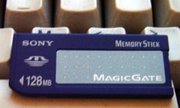Memory Stick
|
|
Memory Stick is a removable memory card format, launched by Sony in October 1998.
Typically, a Memory Stick is used as storage media for a portable device, in a form that can easily be removed for access by a PC. For example, Sony digital cameras use Memory Sticks for storing image files. With a Memory Stick reader (typically a small box that connects via USB or some other serial connection), a user could copy the pictures taken with the Sony digital camera off to his or her computer. Sony uses and has used Memory Sticks in digital cameras, digital music players, PDAs, cell phones, the PlayStation Portable, and in other devices, and the Sony VAIO line of personal computers has long included Memory Stick slots.
The Memory Stick is defined in the minds of many by its proprietary nature, as the grand majority of portable devices that use it are Sony devices, and Sony for long while monopolized its production. (Even now, the only significant third-party licensees that make Memory Sticks are SanDisk and Lexar.) In spite of its proprietary nature (or because of Sony's dogged support for the format), the Memory Stick has outlived almost all other strictly proprietary flash memory formats, and has a longevity comparable only to CompactFlash and Secure Digital.
| Contents |
Different Memory Stick formats and form factors
Memory Sticks include a wide range of actual formats, including two different form factors.
Mstickselect.jpg
The original Memory Sticks were approximately the size and thickness of a stick of chewing gum, and came in sizes from 4 MB up to and including 128 MB. This size limitation became limiting fairly quickly, so Sony introduced the now-uncommon Memory Stick Select, which was similar in concept (if not in execution) to the way in which 5.25" floppy disks used both sides of a disk. A Memory Stick Select was two (or rarely four) separate 128 MB partitions which the user could switch between using a switch on the card. This solution was fairly unpopular, but did allow for users with older Memory Stick devices to use higher-capacity flash memory. The 256 MB Memory Stick Select is still being manufactured by Lexar.
The Memory Stick PRO would be the longer-lasting solution to this problem, and most devices that use the original Memory Stick form factor support both the original Memory Sticks and the PRO Sticks. Memory Stick PROs have a somewhat higher transfer speed and have a maximum size of up to 32 GB according to Sony (As of June 2005 they are available in sizes up to 4 Gigabyte). High Speed Memory Stick PROs are available, and newer devices support this High Speed mode, allowing for faster file transfers. All Memory Stick PROs larger than 1 GB support this High Speed mode, and High Speed Memory Stick PROs are backwards-compatible with devices that don't support the High Speed mode. High capacity memory sticks such as the 2 and 4 gigabyte versions are usually extremely expensive compared to other types of flash memory such as SD Cards and Compact Flash.
The MagicGate standard for Memory Sticks was Sony's response to the music industry's call for an encryption system to allow music downloaded from Sony's Connect downloadable music service to be securely stored. ATRAC3 files downloaded from the Sony Connect service can only be played or copied by an authorized device, as they are specially encrypted. As neither the Sony Connect service nor ATRAC3 became very popular, few users have expressed much interest in the MagicGate standard. Nevertheless, most Memory Sticks sold are MagicGate compatible and all Memory Stick Pro support MagicGate. However, Memory Stick Pro does not support the ATRAC3 format.
The Memory Stick Duo, which is slightly smaller than the competing Secure Digital format, was developed in response to Sony's need for a smaller flash memory card for pocket-sized digital cameras and cell phones. Memory Stick Duos are available in all the same variants as their larger cousins (normal ones limited to 128 MB, larger PRO Sticks, with and without High Speed mode, with and without MagicGate support), and a simple adapter (often sold along with the Memory Stick Duo) allows a Duo to be used in any device that can accept their larger cousins.
Overview of Memory Stick
- Memory Stick (4 up to 128 MB)
- Memory Stick Select (2 bank of 128 MB selectable with a tiny switch on the side of the card)
- Memory Stick MagicGate
- Memory Stick Select MagicGate (same as Memory Stick Select but with MG feature and logo on card)
- Memory Stick Duo Adapter allows Memory Stick Duo cards to function as standard or MagicGate Memory Sticks
- Memory Stick Duo
- Memory Stick Duo MagicGate
- Memory Stick Pro (Note: All Memory Stick Pro and derviative Pro cards as of 2005 have MagicGate, but do not support ATRAC audio format, Maximum MS Pro capcity is eventually 32 GB accoding to Sony, currently 4 GB as of 2005)
- Memory Stick Pro High-Speed
- Memory Stick Pro Duo Adapter allows Memory Stick Pro Duo cards to function just like standard size Memory Stick Pro cards.
- Memory Stick Pro Duo
- Memory Stick Pro Duo High Speed
Specifications
Standard transfer speeds:
- Maximum write speed: 14.4 Mbit/s (1.8 MB/s)
- Maximum read speed: 19.6 Mbit/s (2.5 MB/s)
PRO transfer speeds:
- Transfer: 160 Mbit/s (20 MB/s)
- Minimum write speed: 15 Mbit/s
Form Factors:
- Standard: 50.0 mm (W) x 21.5 mm (H) x 2.8 mm (D)
- Duo: 31.0 mm (W) x 20.0 mm (H) x 1.6 mm (D)
External link
- Memory Stick FAQ (http://www.memorystick.com/en/support/faq.html)de:Memory Stick
it:Memory Stick ja:メモリースティック nl:Memory Stick no:Memory Stick hu:Memory Stick pt:Memory Stick ru:Memory Stick

